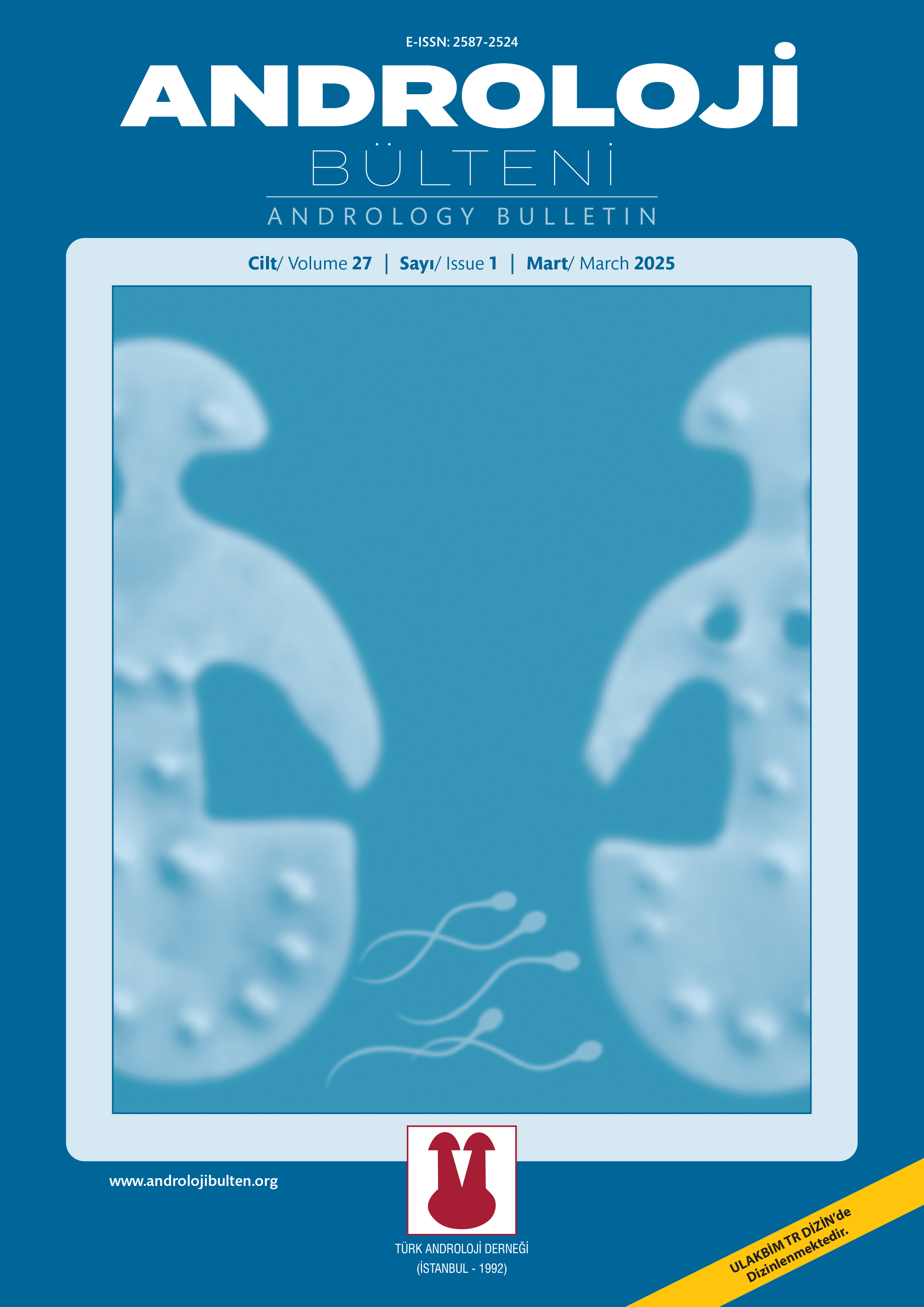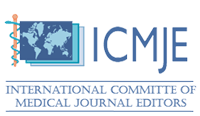INDEXES

Content of this journal is licensed under a Creative Commons Attribution-NonCommercial 4.0 International License.
Volume: 21 Issue: 3 - 2019
| 1. | Cover Page I |
| 2. | Reviewers Page II |
| 3. | From the President Page III |
| 4. | From the Editor Page IV |
| 5. | Contents Page V |
| CLINICAL ORIGINAL ARTICLE | |
| 6. | Comparison of the results of three different surgical methods in the treatment of adolescent varicocele Murat Uçar, Ahsen Karagözlü Akgül, Ahmet Ender Caylan, Bilge Turedi, Mustafa Faruk Usta, Nizamettin Kılıç, Emin Balkan, Erol Güntekin doi: 10.24898/tandro.2019.97268 Pages 83 - 88 OBJECTIVE: In the treatment of adolescent varicocele, there isn’t any consensus and the ideal technique is not yet defined. Open surgery (microscopy-assisted or not) or laparoscopic techniques are surgical methods used in treatment. We planned to compare the results of microscopic, laparoscopic and open varicocelectomy techniques. MATRERIAL and METHODS: Patients who underwent varicocele therapy between 2003–2018 were evaluated retrospectively in 3 groups. Patients who underwent laparoscopic varicocele ligation were included in Group 1, patients who underwent microscopic varicocelectomy were included in Group 2 and patients who underwent subinguinal varicocelectomy were included in Group 3. Three groups were compared in terms for operation and postoperative follow-up data. RESULTS: The study included 113 patients, 30 patients in Group 1, 43 patients in Group 2, 40 patients in Group 3. The mean age was 13.2 years. There was no significant difference between groups in terms of side and varicocele degree. The median operation times for group1.2 and 3 were 55 (35–70), 50 (40–80) and 55 min. (40–70) (p>0.05). The hydrocele development after surgery was detected in 3, 1 and 2 patients, respectively (p>0.05). Varicocele recurrence was not seen in the LVL group, but it was seen in 3 patients in the MV group and in 7 patients in the SV group (p>0.05). Postoperative testicular volume loss was detected in 3 patients in Group 1, 1 patient in Group 2 and in Group 3 no patient was detected. There was no statistical significant different between groups although there were clinical differences between the groups in terms of results or complications. CONCLUSION: In the treatment of adolescent varicoceles, it was found that all 3 techniques can be used successfully but in microscopic or under magnification (via loop) techniques, complication rates seem to be much less and clinical successful rates seem to be much higher. |
| 7. | Effect of duration of marriage on premature ejaculation Erdem Kısa, Mehmet Zeynel Keskin doi: 10.24898/tandro.2019.47113 Pages 89 - 92 OBJECTIVE: Premature ejaculation (PE) is one of the most common male sexual dysfunctions. We aimed to evaluate the relation between the duration of marriage and the ejaculation time in males. MATRERIAL and METHODS: We retrospectively reviewed the records of 697 patients over the age of 18 years, who applied with complaints of longlife PE in our andrology clinic between July 2014 and July 2018. Ejaculation time of the patients in the groups were recorded according to the self-estimated intravaginal ejaculation latency time (IELT) in the clinical assessment. Patients whose ejaculation time was >1 minute were classified group 1 and whose ejaculation time was <1 minute were classified group 2 patients. The ages of the individuals in the study group, age of partners, PEDT scores, marital durations and relationship frequencies were also compared. RESULTS: A total of 541 patients were in group 1 and 156 patients in group 2. Self-estimated IELT was determined as 194.7±21.4 sec in group 1 and 23.1±4.4 sec in group 2. The PEDT score was 5.2±2.4 in group 1 and 15.8±3.1 in group 2 (p <0,001). Group 2 had higher mean duration of marriage (68.4±52.8 months vs 80.4±62.4 months) than group 1, but there were no statistically significant differences. The effect of marriage duration on PE is statistically significant (p=0.016). A 12-month increase in marriage duration results in a 1.1-fold increase in risk of PE. CONCLUSION: This study concluded that an increased marriage duration resulted in an increase in PE risk. Moreover, we think that our findings should be supported by more prospective and comprehensive studies. |
| 8. | The effect of voiding position on post-voiding residue in aging men in turkish society Cavit Ceylan, Şenol Tonyalı, Serkan Doğan, Sedat Yahşi, Emre Uzun doi: 10.24898/tandro.2019.07078 Pages 93 - 96 OBJECTIVE: To investigate the effect of voiding position on postvoiding residue (PVR) in male Turkish population. MATRERIAL and METHODS: Patients who were admitted to the outpatient clinic with lower urinary tract symptoms (LUTS) in 2017–2018 and who were scheduled for ultrasound-guided transrectal needle biopsy (TRIB) due to PSA elevation were included in the study. Demographic information, uroflowmetry parameters [maximal urinary flow rate (Q max), mean urinary flow rate (Q mean)], prostate volumes in transrectal ultrasound were recorded. The patients were divided into two groups according to their habit of voiding: Group 1=Patients voiding at standing-up position; Group 2=Patients voiding at squatting position. RESULTS: A total of 88 patients were included in the study. No significant difference was found between the two groups in terms of PSA levels, prostate volumes, voided volume, Q max, Q average and PVR (p=0.993, p=0.887, p=0.449, p=0.093, P=0.209, p=0.063). There was a statistically significant correlation between age and prostate volume and PVR (p<0.001, p<0.001). CONCLUSION: It has been shown that voiding at standing or squatting position has no effect on post-voiding residual urine volume in elderly Turkish male population. |
| 9. | Views and attitudes of midwife students on premarital sex Saadet Gonca Mavi Aydoğdu, Betül Uzun, Duygu Murat Öztürk doi: 10.24898/tandro.2019.07269 Pages 97 - 104 OBJECTIVE: This study was carried out in order to determine the opinions and attitudes of midwifery students on non-marital sexual intercourse. MATRERIAL and METHODS: The descriptive research was carried out with the students of midwifery department of the Faculty of Health Sciences of Amasya University in 2017–2018 academic year/spring semester (N=86). The data were collected by using two forms which were prepared by the researchers by using the literature and evaluating their opinions and attitudes about the socio-demographic characteristics of the students and out-of-marriage sexual intercourse and analyzed in SPSS package program. RESULTS: The mean age of the students was 20.08±2.18 years. It was determined that 68.6% of the students had sufficient information about sexual intercourse, 58.14% of the students got written information from the related information, 79.07% of them could not speak comfortably with their family and 87.2% stated that their religious beliefs may prevent them from having sexual experiences. There was a significant difference between the knowledge levels of students about sex and their class (p=0.000): 43.33% of the first class, 65% of the second class, 83.33% of the third class and 100% of the fourth class have enough knowledge about sexual intercourse. CONCLUSION: Students can be strengthened in matters such as deciding on relevant issues, taking responsibility for their decisions, acting professionally with the problems they are facing, receiving support for their needs, and affecting the value of the social value judgments. Sexual health related needs should be identified and trainings should be given to the subjects that students need. |
| 10. | Should percutaneuous testicular sperm aspiration be performed before testicular sperm extraction in all patients with azoospermia? Özkan Onuk doi: 10.24898/tandro.2019.09821 Pages 105 - 109 OBJECTIVE: Percutaneuous testicular sperm aspiration (PTSA) is known as an easy and minimal invasive procedure in men who have azospermia. In this study we are in the aim of evaluating if PTSA is beneficial as a first step procedure. MATRERIAL and METHODS: In our study we analyzed the records of 128 patients who underwent mTESE and PTSA with the diagnosis of non-obstructive azoospermia (NOA) retrospectively. The serum levels of total testosterone (T), follicular stimulating hormone (FSH), luteinizing hormone (LH) and prolactine (PRL) were measured in all patients. All the patients underwent genetical analysis. The patients diagnosed with NOA underwent PTSA which was performed by only one surgeon at first, then mTESE was performed secondly by the same surgeon if there was no sperm extraction wşth PTSA. All of 128 patients were evaluated in three groups; sperm extracted patients with PTSA, sperm extracted patients with mTESE and no sperm extracted patients with any procedures. RESULTS: There were no significant differences between the serum levels of FSH, LH, PRL, T and age statistically (p>0.05) but it differs significantly in all three groups regarding the periods of infertility. The patients who have pain were scored with VAS (Visual Analogue Scale) was 1.93±0.96 for the group sperm extracted patients with PTSA; 2.32±0.74 for the group of sperm extracted patients with mTESE and 5.41±1.15 for the group of no sperm extraction with any procedures respectively. CONCLUSION: In this study it cannot be predicted which patient may benefit by the PTSA procedure. We are of opinion that performing PTSA before mTESE procedure may be beneficial regarding to low morbidity risk. |
| 11. | Continence and potency outcomes after robotic radical prostatectomy in the hands of console surgeon with previous experience as a bedside assistant: first 50 cases Hacı İbrahim Çimen doi: 10.24898/tandro.2019.14890 Pages 110 - 114 OBJECTIVE: To present the robotic radical prostatectomy functional results of the console surgeon with previous experience as a bedside assistant. MATRERIAL and METHODS: The medical records of the first 50 patients who underwent robotic radical prostatectomy between September 2016 – July 2018 were reviewed retrospectively. Continence was described as no using pad or using safety pad. Mild incontinence was described as using 1 pad daily while using 2 and more pads described as severe incontinence. Patients with the International Index of Erectile Function (IIEF-5) score >21 were defined as potent, ≤21 were defined as impotent. RESULTS: Mean age was 64.06±6.15 and mean follow-up time was 14.9±6.9 months. Bilaterally, unilaterally and non nerve sparing surgery was performed in 37 (74%), 4 (8%) and 9 (18%) patients, respectively. Clavien grade 3 and higher complication was occurred in only 2 (4%) patients. Surgical margin involvement was detected in 11 (22%) patients and 5 (10%) patients developed biochemical recurrence. Forty (87%) patients were continent and 21 (45.7%) patients were potent at the 6th month postoperatively. CONCLUSION: Having experience as a bedside assistant before console surgery also minimizes complication rates in addition to the advantages of robotic surgery in functional outcomes. |
| REVIEW | |
| 12. | Pathophysiology of varicocele 2019 Ahmet Karakeçi, İrfan Orhan doi: 10.24898/tandro.2019.72621 Pages 115 - 118 Varicocele, which is the most frequently treatable pathology of male infertility, is detected in approximately 13–15% of the normal population. Determination of such high rates in the general population and the detection of semen parameters in normal values in 11.7% of patients has led to new research topics to evaluation of the pathophysiological processes between varicocele and infertility. Conventionally, the possible pathophysiological effect of varicocele on male reproductive system is evaluated by five different mechanisms. These mechanisms are reported as hyperthermia, hypoxia, reflux of toxic cyclical metabolites, hypogonadism, and cadmium accumulation. |
| 13. | Internet and Sexuality Özden Tandoğan, Ümran Oskay doi: 10.24898/tandro.2019.54154 Pages 119 - 122 The Internet is a tool we use frequently in our daily lives and has become an environment used by most people for sexual activities. The popularity of the Internet in our daily lives has also led to changes in sexuality. The low cost of access to sites with sexual content, and the ability to express sexual fantasies on the Internet more popularly increases this popularity. The use of pornography on the Internet is intended for online sexual intercourse and masturbation, but a new environment has been created with sex shops on the Internet. With the widespread use of pornography, adolescent development has also been affected and increased the likelihood of adolescents having sexual intercourse at an early age. False sexuality is learned because of little or no use of internet-based sexual education websites. With the use of the Internet, cost-effective education can be provided to large audiences and sexual health can be improved. The Internet has influenced the diversity of natural sexuality and has made users adopt uniform sexuality. However, it also helps the gay and bisexual men discover their sexuality or reveal their sexual identity. The advantages and disadvantages of the Internet as well as the sexuality are discussed. |
| 14. | Publications and Congress Calendar of Andrology Pages E1 - E2 Abstract | |













